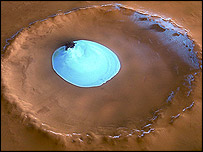
The presence of water makes life a more likely
possibility |
A
giant patch of frozen water has been pictured nestled within an
unnamed impact crater on Mars.
The photographs were taken by the High Resolution Stereo Camera
on board Mars Express, the European Space Agency probe which is
exploring the planet.
The ice disc is located on Vastitas Borealis, a broad plain that
covers much of Mars' far northern latitudes.
The existence of water on Mars raises the prospect that past or
present life will one day be detected.
It also boosts the chances that manned missions can eventually be
sent to the Red Planet.
Highly visible
The highly visible ice is sitting in a crater which is 35 km (23
miles) wide, with a maximum depth of about two km (1.2 miles).
Scientists believe the water ice is present all year round
because the temperature and pressure are not sufficient to allow it
to change states.
Researchers studying the images are sure it is not frozen carbon
dioxide (CO2), because CO2 ice had already disappeared from the
north polar cap at the time the image was taken.
The team have also been able to detect faint traces of water ice
along the rim of the crater and on the crater walls.
Mars is covered with deep gorges, apparently carved out by rivers
and glaciers, although most of the water vanished millions of years
ago.
Earlier this year, the European Space Agency detected what they
called a huge "frozen sea", but it is located below the surface of
the planet.
Large reserves of water-ice are also known to be held at the
poles on Mars.